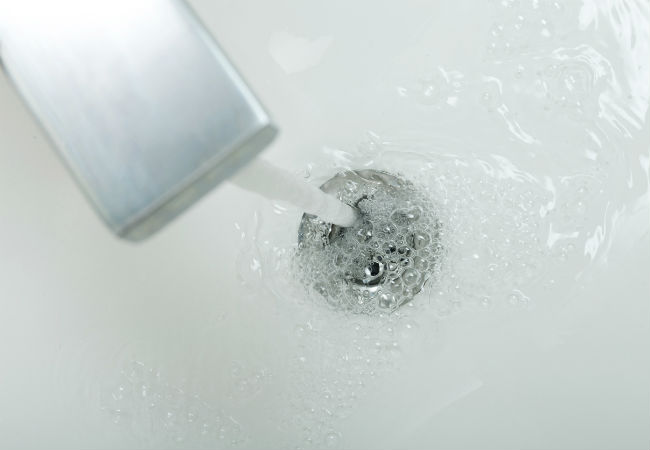Just about every person has got their own theory involving 7 Ways To Fix A Slow-Draining Sink Before You Call A Plumber.

Introduction
We have actually all been there: You're brushing your teeth or cleaning your hands, and you discover the water merging in the sink. Instead of quickly swirling down the drain, it lingers, turning your once-refreshing morning regimen right into a miniature swamp scene. A slow-draining sink isn't just frustrating; it's frequently a sign of larger pipes problems prowling under the surface. Fortunately is that the majority of slow-draining sinks can be repaired with a little expertise, a couple of standard tools, and some perseverance. Ready to tackle this job head-on? Let's roll up our sleeves and dive right in.
Comprehending the Causes of a Slow-Draining Sink
Before you begin poking around in your pipelines, it helps to recognize what could be creating the slowdown. Understanding the root cause makes it simpler to choose the appropriate fix.
Devices and Products You'll Require
The right devices make all the difference. The good news is, you won't need a fully equipped plumbing professional's van to finish the job.
Step-by-Step Overview to Fixing a Slow-Draining Sink
Currently, allow's get involved in the nitty-gritty. This step-by-step procedure will guide you via straightforward techniques to recover your sink's drain.
Step 1: Remove and Tidy the Stopper
Commonly, the stopper (that small plug you lower to block water) is the initial culprit. Remove it meticulously and clean off any type of hair or crud caught around its base. Wash it extensively before placing it back in place.
Step 2: Utilize a Bettor to Displace Debris
Got that bettor ready? Setting it over the drainpipe and provide it a few firm pumps. The idea is to create suction that can loosen up any type of blockage. If you see littles particles drifting up, you get on the appropriate track.
Step 3: Try a Drain Snake or Cord Wall Mount
If the bettor doesn't work, it's time to draw out the drainpipe snake. Gently feed it right into the drain and twist as you go. You may feel some resistance-- that's most likely the clog. Keep twisting and drawing till you remove the blockage. If you do not have a drain snake, a corrected the alignment of cable hanger can operate in a pinch.
Tip 4: Use a Do It Yourself Drain Cleanser
A natural cleaner made from cooking soft drink and vinegar can break down residual gunk. Pour half a cup of baking soda into the drainpipe, followed by half a mug of vinegar. Allow it fizz for around 15 mins, then flush with hot water. This chemical reaction frequently does wonders for minor obstructions.
Tip 5: Reassemble and Evaluate the Sink
Placed every little thing back with each other and run the tap. Does the water currently swirl away at a respectable rate? If yes, provide on your own a pat on the back. If not, don't despair-- there are still a couple of even more dress up your sleeve.
Crucial Tools for DIY Repairs
A plunger is your best beginning point. A tiny, sink-sized bettor creates suction that can displace small clogs. For more persistent clogs, a drain serpent (sometimes called a plumbing's auger) works wonders. A set of handwear covers, a flashlight, and possibly a pair of protective goggles are likewise convenient.
Recommended Cleansing Solutions
Mild meal soap and hot water can aid break down greasy accumulation. A mix of cooking soft drink and vinegar is a tried and true natural remedy, and chemical cleaners provide a more green approach. Keep chemical drain cleansers as a last hope, as they can be rough on your pipelines.
Usual Culprits Behind Slow Drainage
So, what's obstructing things up? Normally, it's a combination of day-to-day particles-- believe hair, soap scum, toothpaste deposit, and remaining food particles. Over time, these little bits build up and cling to the pipeline wall surfaces, slowly narrowing the flow and making it harder for water to go through. In some cases, mineral deposits from tough water can also add to the crud, producing the perfect tornado for persistent blockages.
When is it Time to Do Something About It?
If you discover the water draining pipes slower than typical, it's a great concept to intervene sooner instead of later on. Waiting too long might bring about complete obstructions, undesirable odors, or even pipe damages. If the water takes greater than a few secs to clear out after switching off the faucet, consider it a warning and prepare yourself to place on your DIY hat.
Safety And Security First: Safety Measures and Prep work
Prior to you launch into unclogging mode, think about safety. You're dealing with possibly unclean water and particles, so slip on a pair of handwear covers. If you're utilizing chemical cleaners, guarantee the space is well-ventilated and follow the guidelines on the tag.
Safety Gear and Work Space Configuration
Lay down some old towels or cloths around the sink location to capture sprinkles. Eliminate any kind of things that could enter your method, like soap dispensers or toothbrush owners. Make sure you have good lights-- grab a flashlight if required.
Alternative Approaches for Stubborn Clogs
Not all blockages are developed equivalent. If your sink still refuses to coordinate, take into consideration these alternate solutions.
Sodium Bicarbonate and Vinegar Technique
We currently discussed this, yet it's worth noting again. This gentle, environmentally friendly method is much safer than chemical cleaners and frequently fairly effective.
Enzymatic Drain Cleaners
Enzyme-based cleaners use natural bacteria to digest organic matter. They're an outstanding choice if you're wanting to stay clear of rough chemicals. Simply bear in mind, they might take a bit longer to work their magic.
Chemical Drain Cleansers: Advantages And Disadvantages
Chemical cleaners can blast through challenging obstructions quick, but they're not without drawbacks. They can create warm and fumes, damages pipelines if used exceedingly, and posture environmental threats. Use them sparingly, and always comply with the directions carefully.
Safety Nets to Keep Your Sink Flowing
Prevention is the most effective remedy. By adopting a couple of easy habits, you can maintain your sink from slowing down to begin with.
Regular Cleaning Up Habits
Wipe down the sink container and fixture area frequently. Get rid of hair or food particles prior to they have an opportunity to wash down the drain.
Avoiding Unsafe Materials Away
Reconsider prior to discarding coffee premises, grease, or coarse vegetable scraps down the sink. These offenders cling to pipe wall surfaces, developing obstructions over time.
Routine Upkeep Checks
Arrange a quick monthly examination. Run warm water through the sink for a few minutes, taking note of the flow. If it seems slow-moving, act quick before it becomes a full-blown blockage.
When to Call an Expert Plumbing Technician
Often, regardless of how difficult you try, that obstruct just will not move. That's when it's time to generate the pros.
Signs That Suggest an Extra Major Problem
If your sink drains pipes gradually despite several efforts, or if you see water supporting in other fixtures (like your shower or toilet), you might have an extra significant plumbing concern prowling much deeper in the system.
Stabilizing Do It Yourself Initiatives with Expert Help
While DIY can conserve you cash and offer a feeling of accomplishment, there's no pity in calling a professional. A specialist plumbing can evaluate your entire pipes configuration, making sure there's no underlying damage or lasting issue that could cost you extra in the future.
Contrasting Costs and Long-Term Solutions
Prior to making a decision, take into consideration the big picture. An economical, quick fix may address the problem temporarily, however investing in a much more irreversible solution might conserve you money and stress and anxiety in the long run.
Considering the Expenses of DIY vs. Expert Repairs
DIY repairs commonly set you back bit greater than the rate of a bettor or a container of cooking soft drink. Specialist services, on the other hand, included a price tag but may prevent repetitive issues and expensive fixings later.
Purchasing Quality Fixtures and Upgrades
If your sink's design adds to regular blockages, it may be worth upgrading to higher-quality fixtures or changing the pipes format. Consider this an investment in your home's capability and convenience.
Final thought
A slow-draining sink can feel like a small irritability, yet it's typically an indicator that your plumbing needs a little TLC. By understanding the origin, employing the right devices and techniques, and devoting to easy safety nets, you can keep your sink streaming openly. And when all else fails, never ever wait to contact a specialist-- your home's plumbing deserves the investment in care and upkeep.
Three Common Ways to Fix a Slow Drain
Baking Soda Method
Boil a full pot of water. Measure out cup of baking soda and pour it down the drain. Then take cup of the magical cleansing substance known as white vinegar and drop that down there too. Allow the mixture to fizz in the drain for five minutes as the vinegar and baking soda combine. Now dump in that whole pot of boiling water. This combination of cleaning substances should clear out anything that is causing your sink to drain slowly. If it doesn t...
Zip-It
If the baking soda method doesn t clear out your drain, it may be because a significant amount of hair and/or other debris has collected there and you need to remove it. Purchase a Zip-It tool at any home improvement or hardware store and insert it into your drain. It will catch any collected hair or debris that s blocking the flow of water. Pull it out. If it s got a big clump of hair, etc. on the end, you ve probably got your culprit.
Drain Cleaner
If these methods don t work, there is the standard drain cleaner that you can also buy in a hardware store or even your local grocery store. It s better if you can use a household solution, but these drain cleaners often work in a pinch. They re very simple to use. You generally just dump them in your drain and wait. If even this method is not effective, it may be time to call the plumber.
https://www.mrrooter.com/oneida/about-us/blog/2017/july/three-common-ways-to-fix-a-slow-drain/

I was brought to that article about 7 Ways To Fix A Slow-Draining Sink Before You Call A Plumber through an associate on our other website. Enjoyed reading our write-up? Please share it. Let someone else check it out. I enjoy your readership.
Check This Out
 Jake Lloyd Then & Now!
Jake Lloyd Then & Now! Judd Nelson Then & Now!
Judd Nelson Then & Now! Andrea Barber Then & Now!
Andrea Barber Then & Now! Michael Jordan Then & Now!
Michael Jordan Then & Now! Bernadette Peters Then & Now!
Bernadette Peters Then & Now!